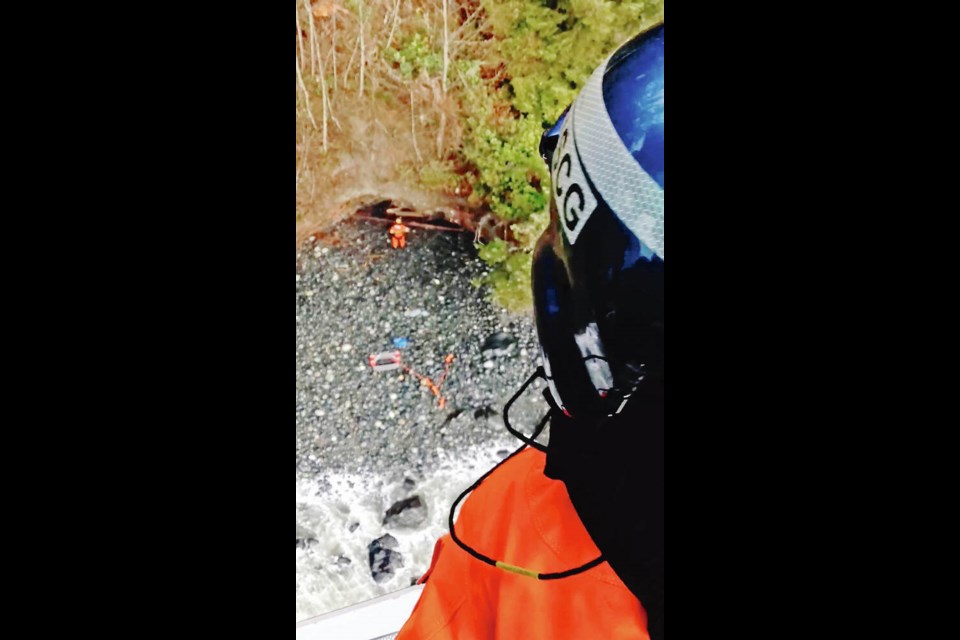By the time they reached the stricken sailboat near Jordan River, it was almost submerged, the lone man aboard desperately holding on in the 1 a.m. madness as Wednesday’s storm dashed it against the rocks.
Up in the U.S. Coast Guard helicopter, flight mechanic Austen Marshall was attempting to figure out where to winch down rescue diver Luke Wengrin.
It was no good trying to drop Wengrin on the boat, which was being bashed violently between two rocks, its drunkenly lurching mast a hazard to the aircraft. So, with the pilots wrestling to keep the MH-65 Dolphin in position as 30-knot winds gusted to 50 and a wall of Vancouver Island trees loomed from the nearby shore, Marshall lowered the diver to one of the rocks from a height of maybe 20 metres.
It was pitch black — the powerless boat had lost its lights — and the roar of the storm and the helicopter made it hard to hear, but Wengrin managed to yell at the man to wait until a wave tossed the boat toward the diver, then jump, which the man did. “I grabbed him, and pulled him onto the rock,” Wengrin said.
The guy, wearing just a raincoat and life-jacket, not a survival suit, was in a bad way, hypothermic. He was also barefoot, and the rocks were covered with razor-sharp shellfish. Wengrin carried, dragged and swam the man to a safer extraction point, from which Marshall winched him up. “He was extremely lethargic,” Marshall said. “He couldn’t really speak.” All they really knew was that he was Canadian, had been on the boat with three dogs.
One of the dogs was spotted on shore. Wengrin bearhugged the animal so that it wouldn’t jump as Marshall winched them up in the basket together.
There were two more dogs down there somewhere, but, running a bit low on fuel and with the health of the rescued man in question, the helicopter turned for the Canadian Coast Guard station in Victoria, where an ambulance awaited.
Then it was back to Port Angeles and back to bed for the helicopter crew, another cross-border mission complete.
This is the way it often goes around here, where the question of who comes riding to the rescue is determined not by the flag sewn to the uniform, but who is in the best position to help. Canada and the U.S. might occasionally butt heads over softwood or salmon, or whatever, but this is one area where they co-operate well.
Take that most recent example. It began just after 11 p.m. on Tuesday when the U.S. Coast Guard picked up a mayday call from the sailboat, which had run aground five kilometres west of Jordan River.
The Americans called the Joint Rescue Co-ordination Centre in Victoria, and between them they worked out that it would be fastest to send the helicopter from the base in Port Angeles, where they keep a chopper crew ready 24 hours a day, 365 days a year.
Actually, the chopper returned to the scene the next morning, too, to see if there was any pollution from the wreck to worry about. While there, the crew spied one of the missing dogs stranded on an isolated beach. They flew it to Victoria, presumably to be reunited with an owner whose identity and condition have not been divulged. (A social media post later said the man was looking to recover his phone, wallet, ID and clothing, and urged people to be on the lookout for the remaining dog, a black male Rottweiler named Ferrari, which had been wearing a collar.)
Again, this sort of cross-border co-operation is not rare. Direct telephone lines link the Victoria rescue centre with its counterparts in Seattle, Washington and Juneau, Alaska. Sometimes it’s them helping us, sometimes it’s us helping them.
In May, a helicopter from Port Angeles helped in the rescue of two survivors (another person was not be found) after a sportfishing boat overturned off Nitinat Narrows on the west coast of the island. At other times, it has been Victoria-based rescue crews that have been dispatched to Washington’s San Juan Islands, or the Canadian Coast Guard’s two hovercraft and Richmond-based dive team that have headed south. Cormorant helicopters from Vancouver Island fly down to Puget Sound when their American counterparts are down for maintenance or tied up on other calls. “It happens a lot,” said Petty Officer Steve Strohmaier of the U.S. Coast Guard.
One of the most dramatic, albeit spontaneous, examples of co-operation came in 1992 when, with head-high waves crashing around them, the three volunteers crewing the coast guard auxiliary’s Spirit of Sooke were having a terrible time rescuing a sloop-rigged sailboat that a storm had already knocked over three times near Race Rocks. The couple on the sailboat was wide-eyed, the man white-knuckled to the wheel, the woman below decks, screaming into the radio.
Suddenly, the nuclear-powered submarine USS George Washington Carver heaved out of the sea. More than a football field long, it formed a perfect breakwater, allowing the rescue to proceed. It had picked up the sailboat’s mayday call while coming in from the Pacific.
Wednesday’s rescue was also right up there when it came to drama.
“That was definitely the most wild one I’ve ever done,” Marshall said.
“It was a rough one,” concurred Wengrin.
As for who responds to emergencies in which country, Wengrin said it’s just a question of whose assets are best positioned to assist.
“When we have the ability to help, we do.”
jknox@timescolonist.com
>>> To comment on this article, write a letter to the editor: letters@timescolonist.com

